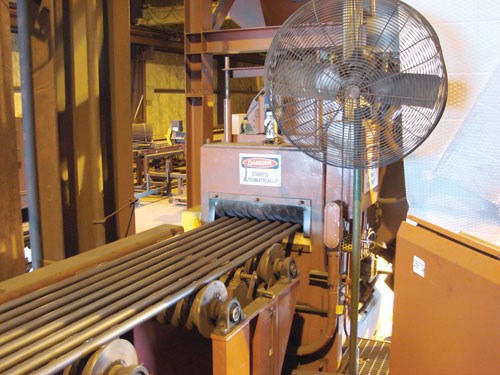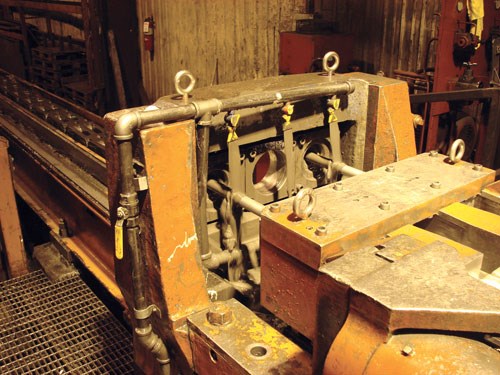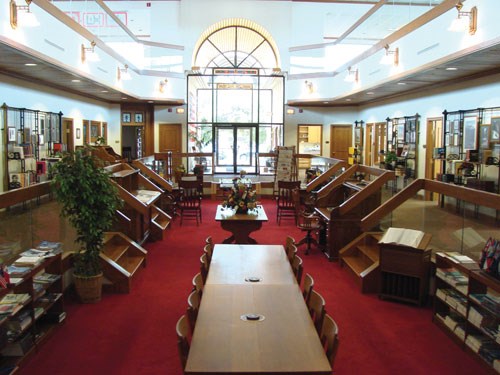Straight From The Source
Seeing the cold drawing process up close can provide an entirely new appreciation of the barstock used in a shop. Here's how one mill makes the most of the process.
Two Roll Straightener
Who says you can’t put a round peg in a square hole? Watching a 1 5/16-inch-diameter cold steel bar get pulled through a 1 1/4-inch carbide die using nothing but the sheer mechanical power built into the carriage of a McKay draw bench proves that where there’s a will, there’s a way. It’s quite a sight to see these 29-foot, 4-inch bars get drawn to lengths of 32 feet as they’re literally stretched, rounded and smoothed to the desired finish.
This process is only a part of everyday business at New Dimension Metals, a cold draw bar mill focused on providing quality materials in a flexible, reliable manner. The company blossomed as a supplier to one of its sister companies, and has expanded to become an alternative to the big steel industry. Today it prides itself in the entrepreneurial spirit reflected in its name, aiming to go the extra mile to provide customers what they want. Instead of offering only 12- or 20-foot bars, New Dimension is willing to cut to length as dictated by the needs of the customer. Diameters range from ¼-inch to 4-inch rounds, squares 7/16 inch to 2 inches and hexes 5/16 inch to 2 ¾ inches. And, as is the case in pretty much any cold draw mill, it’s an amazing process the bars go through between the time they are delivered from the hot mills until they are loaded on the truck and on the way to the customer.
Drawing It Out
Hot-rolled bar is delivered from the mills in the form of straight lengths as long as 48 feet or coils of varying lengths, based on diameter. The first step in the drawing process at the company is to send the material through the shot blast system to remove the hot roll scale, which is abrasive on the cutting tool and would hurt machinability. Another advantage to the shot blasting is the additional roughness it puts on the bar. A good shot-blasted surface helps to keep the oil on the bar as it is drawn. On the McKay draw bench, bars are fed eight across, but separated to allow the shot to completely treat the surface.
Because the coils are so much larger than the individual bars, they require considerably more effort for handling. Initially, they are stored outside, for space considerations. Because they are subject to the elements, they need to be watched more closely. The company turns inventory quickly, and minor rusting is easily remedied with shot blasting. Only after pitting begins (which could occur after several months in the weather) does machinability of the bar become questionable.
Where the larger size of the coils comes even more into play is in the shot blasting process itself. The coils are first blasted offline in a cabinet blaster. Although offline blasting requires an extra handling of the coils, a single cabinet unit can easily feed three or more separate coil-fed drawing lines, eliminating the need to add and maintain three different inline blasters.
When a coil comes in off the truck or out of the stock yard, a forklift carries it to the cabinet blaster. The operator lowers the coil, cuts the bands to loosen it, then loads the coil onto the arm in the cabinet. After a few rotations of the arm, the coil is spread enough for thorough application of the shot in the blasting process. The entire process takes about five minutes, and the coil is then ready to be loaded into the drawing line. According to Mike Mulligan, sales manager, “The offline blaster has a big effect on our production line. In a perfect world, we would shot blast everything inline without touching the coil more than once, but this really does a great job of cleaning the coil and removing the scale. To get the same results inline, we would have to slow the lines down, and that would sacrifice efficiency.”
On one of the coil lines, New Dimension does run an inline blaster, but this is a secondary blasting process that adds a little more roughness to the material so the lubrication will stick better.
After the shot blasting process, the material is sent through the drawing machines. New Dimension has seven separate drawing lines, including a recently added Schumag II-B combined drawing line for producing cold drawn bars from hot roll coils. This machine will also eddy-current rounds and shapes inline.
As one might expect, it’s a noisy, oily environment. Keeping lubrication on the bar as it is drawn down is very critical because so much heat and friction is created. With so much oil in use in an open environment, some is bound to end up on the floors. As New Dimension found out, floor dry is not a good solution for a mill. If it gets into the bar bundles, the abrasive nature of the substance will cause problems with the surface finish of the bars. Instead, the company keeps the floors clean with daily scrubbing and porous mats to absorb the rest.
Straightening is the last operation on the bar before being bundled and shipped. The bars are dropped down and spread on the straightener carriage, allowing it to pick one bar at a time and push it through. As with the other operations, the company tries to eliminate as much operator involvement as possible. In addition to automating the process wherever possible, New Dimension eliminates any “steel on steel” contact in order to preserve the surface of the finished bars.
New Dimension Metals has refined its cold drawn bar process so it can provide quality and options in materials while maintaining its family business principles. Mr. Mulligan explains, “Many people look at business in such a way that you either have to be a low-cost producer or a value-added supplier, and the guys in the middle get squeezed out. Our goal is to fulfill a specific need in the supply chain, and our role can vary depending on the customer needs and the requirements of the job. We strive to understand and meet the customers’ needs and not be constrained by preconceived notions of what a supplier should be.”
Material Concerns
The hottest topic in the industry right now for raw materials seems to be cost and the surcharges and pricing of steel. Iron ore is at record highs, and scrap is in a very short supply. But perhaps the biggest contributor is the weak dollar, drastically limiting the supply of foreign steel—in particular, 12L14. This grade’s source is foreign-dominated, with essentially only one domestic melt source. The majority of 12L14 melt comes from either Europe (primarily Great Britain and Germany) or South America.
Cold draw mills such as New Dimension, as sort of middle men in the supply process, buy from the hot mills, produce the finished bars and deliver them to the customer. The hot mills add the surcharges, based on the market conditions. These surcharges, then, are typically handed down through the supply chain, all the way to the shops.
Mr. Mulligan explains, “The hot mills are dictating the prices. We don’t have much choice but to pass it on to our customers. We encourage them to pass the cost on to their customer base. In a sense, we’re in the same boat as the machining world, as consumers of steel with no real control of the prices. So we do constantly try to improve the processes that we control and look for the latest opportunities where our efforts can provide value to the customers.”
New Dimension has been trying to be as transparent as possible when it comes to fluctuating prices. “We can arm our customers with information about what’s happening,” Mr. Mulligan says. “We let them know what our scrap dealers and suppliers are telling us. We don’t have a crystal ball, but we at least give them our best estimate about what to expect based on the information that’s out there, and then guide them in how to deal with the challenges.”
Cold draw mills find themselves dealing with immovable forces on both sides. The hot mills set the prices while shops pull the other direction because of established customer contracts with little or no variance. But the shops need to be disciplined about passing the costs on to the customers whenever possible, or they will be the ones losing the profits at the end of the day. And that’s never easy.
Related Content
Grob Systems to Host Machining, Automation Technology Event
Grob’s event brings together 21 industry partners for informative seminars and live machining demonstrations highlighting machining strategies for optimizing the production of complex aerospace, medical and mold/die parts.
Read MoreJR Machine Launches Expansion Strategy, Hires New CEO
An investment from Schneider Resources Holding positions JR Machine to grow in emerging markets such space exploration and green energy.
Read MoreKennametal Enhances High-Performance Drill Lineup
The KenDrill HPR Solid Carbide Long Length Drills lineup is well suited for aerospace, transportation, general engineering, energy and earthworks shops seeking increased wear resistance, toughness and durability.
Read MoreUnited Grinding Partners With MDI Machine Tools to Expand Texas Distribution
United Grinding North America collaborates with MDI Machine Tools to bring advanced grinding and machining solutions to key Texas industries like aerospace and automotive.
Read MoreRead Next
Important Machining Factors of Carbon Steels
Learn the factors that contribute to carbon steels and their machinability as well as the 1214 steels, 1215 steels and 1018 steels, other grades, and more.
Read MoreHow To (Better) Make a Micrometer
How does an inspection equipment manufacturer organize its factory floor? Join us as we explore the continuous improvement strategies and culture shifts The L.S. Starrett Co. is implementing across the over 500,000 square feet of its Athol, Massachusetts, headquarters.
Read MoreFinding the Right Tools for a Turning Shop
Xcelicut is a startup shop that has grown thanks to the right machines, cutting tools, grants and other resources.
Read More



























